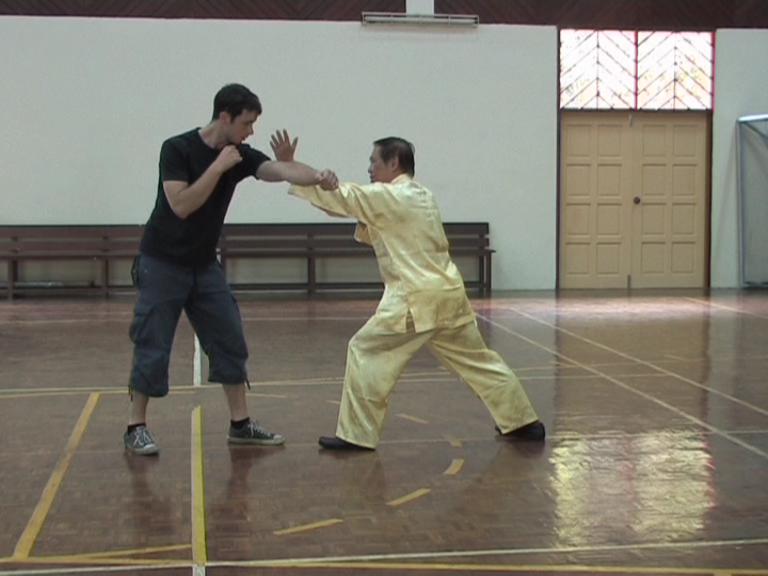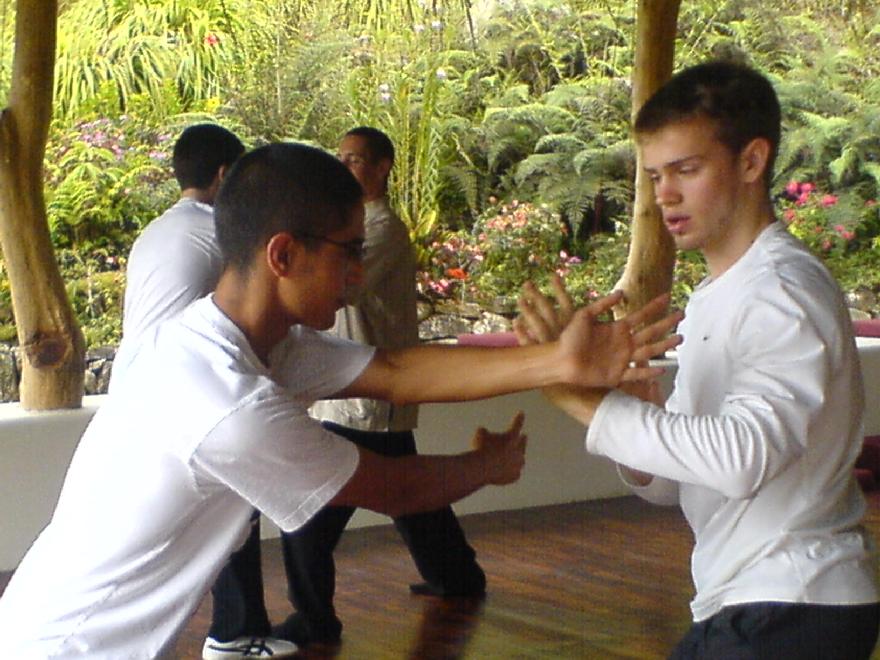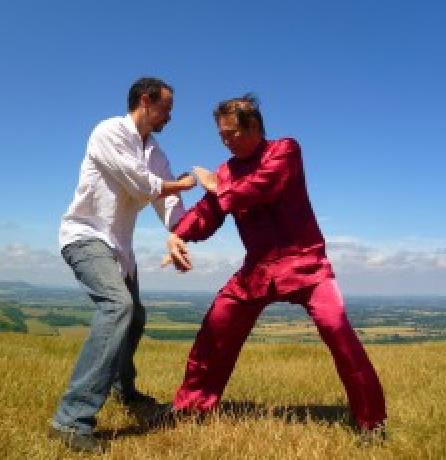MEN KIEW OR ASKING BRIDGE

Grandmaster Wong applies the skill of Asking Bridge to defect the attacks from a physically stronger and bigger-sized Boxer
A few people have asked what Asking Bridge is. A short, apt answer is that it is the Shaolin counterpart of Taijiquan Pushing Hands.
Regarding Pushing Hands, I was surprised and impressed with Robin's (Sifu Robin Gamble's) comment a few years ago, which you may find beneficial to know. He said that the footwork in the Pushing Hands we practiced in Wahnam Taijiquan was the most amazing thing he had learnt. Coming from Robin, this comment has much significance. He spent some time traveling in China learning from some of the best masters he could find there.
Robin soon tested out the Pushing Hands footwork he learnt at my Intensive Taijiquan Course. He attended a Taijiquan conference where some of the best-known Taijiquan instructors were present. After the conference, they had some Pushing Hands sessions. Robin, who was young and new, was very surprised that he could easily push away experienced instructors, including some well-known masters.
Robin told me that at first he thought they were joking, just fooling around with him, until a master became visibly annoyed. Indeed, some of our Shaolin instructors have found Taijiquan Pushing Hands so useful that they have asked me whether we could include it in the Shaolin syllabus too.
Actually we have Pushing Hands in Shaolin, but because our Shaolin material is so extensive that it is not formally taught. I pondered over the same question in my younger days, wondering why such a useful methodology was not found in Shaolin, and discovered with hindsight that "chai sou" or "Kneading Hands" and "chi sau" or "Sticking Hands" are counterparts of Pushing Hands in Five-Ancestor Kungfu and Wing Choon respectively.

A Pushing Hand session during a regional Taijiquan course on the Blue Mountain
Kneading Hands and Sticking Hands were formerly taught, but I was not as lucky as our Shaolin Wahnam students today. This, of course, is no slight to my teachers, who were the best I could find. It was just that conditions were very different.
I spent about two years on Kneading Hands, for example, but did not have any idea at all that it was meant to train and test internal force, hand sensibility and stance stability. In other words, even training for two years in Kneading Hands I had no discernable internal force, hand sensitivity or stance stability from the training, otherwise I would know the purpose of the training from direct experience.
What I remembered most vividly was when my siheng, who was about my size, placed his arm on mine during Kneading Hands, I could not move his or mine, and if I tried hard I would tumble over while he remain solid like a rock. Now if I teach Kneading Hands in a Five-Ancestor Kungfu course, which I intend to do so in future, I am confident that course participants will be able to experience internal force, hand sensitivity and stance stability during the course itself, just as course participants of the Wing Choon course clearly felt the benefits of Sticking Hands.
In Hoong Ka Kungfu we have "men kiew" or Asking Bridge, but it is not taught formally like Pushing Hands, Kneading Hands and Sticking Hands are. Both my Hoong Ka (Shaolin) teachers, Uncle Righteousness and Sifu Ho Fatt Nam, talked about Asking Bridge, and demonstrated its functions which benefited me much in my combat application. If you look at the video on Shaolin Double Tiger Claws where I sparred with Anthony (Sifu Anthony Korahais) and the picture series on Fierce Tiger Descends Mountain where I sparred with Ronan (Sifu Ronan Sexton), you can see a lot of applications of Asking Bridge.
Asking Bridge is very useful. Hence, when Markus (Sifu Markus Kahila) suggested to me to teach a course on Asking Bridge at the First Shaolin Wahnam Winter Camp in Finland, I was very happy. It gives me a good opportunity to crystallize my understanding of Asking Bridge, including benefits from Pushing Hands, Kneading Hands and Sticking Hands, into a coherent system for the benefit of our Shaolin Wahnam instructors and students.
The course will be both extensive and comprehensive. It includes footwork, internal force, hand sensitivity, stance stability, and counters against all categories of attack as well as against other martial arts. The course will be a lot of fun, hopefully under the spectacular North Polar Lights.

Sifu Tim and Grandmaster Wong enjoying Chi Sau or Sticking Hands
